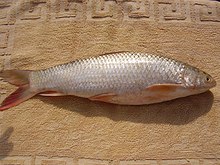Tor putitora: Difference between revisions
Appearance
Content deleted Content added
no image, and in any case doesn't belong here (same claim in main section of article has had "citation needed" for more than half a year) |
No edit summary |
||
| Line 5: | Line 5: | ||
| status_system = iucn3.1 |
| status_system = iucn3.1 |
||
| status_ref = <ref name=IUCN>{{IUCN2011.2 |assessors=Jha, B.R. & Rayamajhi, A. |year=2010 |id=166645 |title=Tor putitora |downloaded=22 January 2012}}</ref> |
| status_ref = <ref name=IUCN>{{IUCN2011.2 |assessors=Jha, B.R. & Rayamajhi, A. |year=2010 |id=166645 |title=Tor putitora |downloaded=22 January 2012}}</ref> |
||
| image = |
| image = Mahasher.JPG |
||
| image_width = |
| image_width = |
||
| image_caption = |
| image_caption = |
||
Revision as of 09:27, 5 October 2014
| Tor putitora | |
|---|---|

| |
| Scientific classification | |
| Kingdom: | |
| Phylum: | |
| Class: | |
| Order: | |
| Family: | |
| Genus: | |
| Species: | T. putitora
|
| Binomial name | |
| Tor putitora (F. Hamilton, 1822)
| |
Tor putitora, the Putitor mahseer, Himalayan mahseer or golden mahseer, is an endangered species of cyprinid fish that is found in rapid streams, riverine pools and lakes in the Himalayan region and south Asia, ranging from Iran south to Sri Lanka, and east to Thailand.[1] It is a popular gamefish, the largest species of mahseer, and can reach up to 2.75 m (9.0 ft) in length and 54 kg (119 lb) in weight, though most caught today are far smaller.[2] It is threatened by habitat loss, habitat degradation and overfishing, and it is estimated that it already has declined by more than 50%.[1] It is the National fish of Pakistan (unofficial).[citation needed]
References
- ^ a b c Template:IUCN2011.2
- ^ Froese, Rainer; Pauly, Daniel (eds.) (2012). "Tor putitora" in FishBase. January 2012 version.

